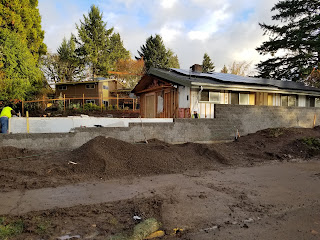Our Sangha chants a version of the Four Great Bodhisattva Vows. Early on, I was intrigued and confused about their meaning. Currently I study a variant inspired by Hui-neng, shared below.
The beings in my own mind are infinite; I vow to free us.
The delusions in my own mind are infinite; I vow to end them.
The teachings in my own nature are inexhaustible; I vow to study them.
The Buddhahood in my own nature is always present; I vow to continually awaken to it.
 What These Vows Mean To Me
What These Vows Mean To Me
These vows are part of my daily practice. I have used some version of the 4 Great
Bodhisattva Vows almost since the beginning of consciously following the Buddha
path. Hui-neng’s version of the vows had
the largest impact on me. Intuitively,
they all seemed to point north. Hui-neng’s version brought clarity that I
hadn’t understood previously. In
particular, I found the added phrases “in my own mind” and “in my own nature”extremely
clarifying. The following is my current
understanding of each of the vows.
The beings in my own mind are
infinite; I vow to free us.
This vow talks about my relationship to the other beings on
the planet. It describes how I fabricate
stories in my mind about these other beings.
It points to how those fabrications become the basis of the way I
interact with others. The separation
from others.
How does this happen?
I believe most are subconscious thoughts of my habituated mind. Many are
petty. “They smoke, they are too fat,
they are too thin, they are too old, they are too young, they are too
conservative; they are too liberal, they are…[the list is infinite like the vow
says.] All categorize, compartmentalize, and minimize. In the process of
labeling, my habituated mind creates a barrier to each individual’s ability to freely
express their buddha nature.
My ego uses these barriers to protect itself at the expense
of others. Samsara 101.
Freedom occurs when the fabrications are realized and
released or dropped. Then Buddha nature
has the opportunity to be expressed and shared – freeing us both – no
separation.
The delusions in my own mind are
infinite; I vow to end them.
While the first vow focuses on the fabrications I create
about others, I see this vow focusing on the fabrications I create about
myself.
How does this happen?
I believe most are subconscious thoughts of my habituated mind. While growing to adulthood I received many
messages like the ones described in the first vow. My ego learned to avoid the painful messages
and seek the pleasurable ones. Mental,
physical, and verbal defenses were erected and automated. I built my own container. This container continuously
prevents me from easily and fully expressing my Buddha nature just like it
impedes others from expressing theirs.
The power of pain avoidance combined with habituation make
this a particularly difficult vow to fulfill.
In reality, this vow and the first vow are the same vow from two vantage
points.
Just sitting; continually bringing awareness to the
thoughts that arise; drifting and returning; seeing the protective fabrications
and recognizing it as illusion – this is the basis of my practice.
The teachings in my own nature are
inexhaustible; I vow to study them
This one is trickier than it appears. It is seductive because at first it sounds like it is
about “ME”. My ego perks up just reading
it.
Once I see my ego doing its thing, I can settle into the
true vow. I see this vow as the action
step to the first two vows. It points to
the method for untangling the habituated and protective barriers I
created. It says “bring awareness”,
“clarify the fabrications”, and do it continually. I believe that this is the path to emptiness,
and I believe emptiness is when I naturally express Buddha nature instead of my
ego nature.
The Buddhahood in my own nature is
always present; I vow to continually awaken to it.
The original wording provides encouragement for the Buddha
way. The way I find this vow to be most
helpful is by the constant reminder that Buddha nature is inherent. My practice is to express it by living the
other vows continuously.
I have moments of increased clarity. I have
moments of delusion. Most of the time I’m in delusion I’m not aware
I’m in delusion. Occasionally awareness practice breaks through. It’s
fascinating when it does. Wow – “how did that fabrication take hold?” I do find that consistent sitting increases the frequency of awakening in the
midst of delusion.
Namaste and Friendly Bows _/|\_
Mark/Koun


